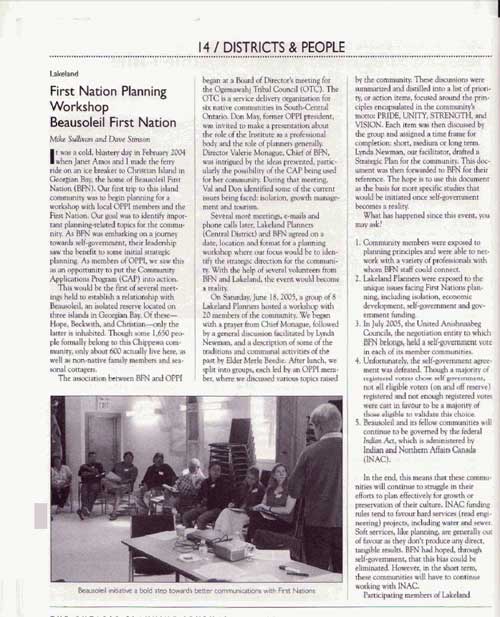Mike Sullivan and Dave Stinson
It was a cold, blustery day in February 2004 when Janet Amos and I made the ferry ride on an ice breaker to Christian Island in Georgian Bay, the home of Beausoleil First Nation (BFN). Our first trip to this island community was to begin planning for a workshop with local OPPI members and the First Nation. Our goal was to identify important planning-related topics for the community. As BFN was embarking on a journey towards self-government, their leadership saw the benefit to some initial strategic planning. As members of OPPI, we saw this as an opportunity to put the Community Applications Program (CAP) into action.
This would be the first of several meetings held to establish a relationship with Beausoleil, an isolated reserve located on three islands in Georgian Bay. Of these—Hope, Beckwith, and Christian—only the latter is inhabited. Though some 1,650 people formally belong to this Chippewa community, only about 600 actually live here, as well as non-native family members and seasonal cottagers.
The association between BFN and OPPI began at a Board of Director’s meeting for the Ogemawahj Tribal Council (OTC). The OTC is a service delivery organization for six native communities in South-Central Ontario. Don May, former OPPI president, was invited to make a presentation about the role of the Institute as a professional body and the role of planners generally. Director Valerie Monague, Chief of BFN, was intrigued by the ideas presented, particularly the possibility of the CAP being used for her community. During that meeting, Val and Don identified some of the current
issues being faced: isolation, growth management and tourism.
Several more meetings, e-mails and phone calls later, Lakeland Planners (Central District) and BFN agreed on a date, location and format for a planning workshop where our focus would be to identify the strategic direction for the community. With the help of several volunteers from BFN and Lakeland, the event would become a reality.
On Saturday, June 18, 2005, a group of 8 Lakeland Planners hosted a workshop with 20 members of the community. We began with a prayer from Chief Monague, followed by a general discussion facilitated by Lynda Newman, and a description of some of the traditions and communal activities of the past by Elder Merle Beedie. After lunch, we split into groups, each led by an OPPI member, where we discussed various topics raised by the community. These discussions were summarized and distilled into a list of priority, or action items, focused around the principles encapsulated in the community’s motto: PRIDE, UNITY, STRENGTH, and VISION. Each item was then discussed by the group and assigned a time frame for completion: short, medium or long term. Lynda Newman, our facilitator, drafted a Strategic Plan for the community. This document was then forwarded to BFN for their reference. The hope is to use this document as the basis for more specific studies that would be initiated once self-government becomes a reality.
What has happened since this event, you may ask?
- Community members were exposed to planning principles and were able to network with a variety of professionals with whom BFN staff could connect.
- Lakeland Planners were exposed to the unique issues facing First Nations planning, including isolation, economic development, self-government and government funding.
- In July 2005, the United Anishnaabeg Councils, the negotiation entity to which BFN belongs, held a self-government vote in each of its member communities.
- Unfortunately, the self-government agreement was defeated. Though a majority of registered voters chose self government, not all eligible voters (on and off reserve) registered and not enough registered votes were cast in favour to be a majority of those eligible to validate this choice.
- Beausoleil and its fellow communities will continue to be governed by the federal Indian Act, which is administered by Indian and Northern Affairs Canada (INAC).
In the end, this means that these communities will continue to struggle in their efforts to plan effectively for growth or preservation of their culture. INAC funding rules tend to favour hard services (read engineering) projects, including water and sewer. Soft services, like planning, are generally out of favour as they don’t produce any direct, tangible results. BFN had hoped, through self-government, that this bias could be eliminated. However, in the short term, these communities will have to continue working with INAC.
Participating members of Lakeland Planners made some valuable local contributions to outreach and professional development by volunteering their time to this worthy endeavour. Both Beausoleil First Nation and Lakeland Planners look forward to future sessions which can assist both groups in learning more about each other and the principles which we practise.
We would like to personally thank the following members for volunteering their time to ensure the success of this event: Janet Amos, Ruth Coursey, Wes Crown, Carolyn Glaser, Brian Goodreid, Don May, George McKibbon, Lynda Newman, Dave Stinson, and Kelly Weste.
Mike Sullivan, MCIP, RPP, is a senior environmental planner at LGL Limited, and a member of OPPI Council. He can be reached at msullivan@lgl.com. David J. Stinson, MCIP, RPP, is a partner of Incite Planning and can be reached by Email David J. Stinson

